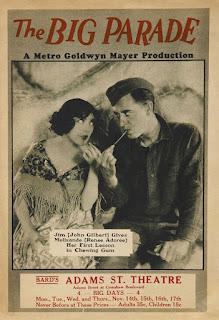
Released only seven years after the Armistice that ended World War I, King Vidor’s The Big Parade gave audiences what, at the time, was the harshest depiction of warfare ever to grace the silver screen.
As the movie opens, we’re introduced to Jim Apperson (John Gilbert), the idle son of a millionaire businessman (Hobart Bosworth). When war breaks out, Jim, caught up in the patriotic fervor, enlists in the army, winning the respect of both his father and his fiancé Justyn (Claire Adams).
Once in France, Jim - whose unit spends several weeks training in the rear echelon - befriends fellow recruits Slim (Karl Dane) and Bull (Tom O’Brien), and he even falls in love with French peasant Melisande (Renée Adorée). But when the call comes for them to march to the front lines, Jim and his comrades are quickly introduced to the terrible, frightening realities of trench warfare.
The first half of The Big Parade is dedicated to building its characters, establishing both the camaraderie that develops between Jim, Bull, and Slim as well as Jim’s whirlwind romance with Melisande. These early scenes are lighthearted and, at times, even comical; soon after arriving in France, Jim and the others are ordered to shovel pig manure, a sequence that ends with a big laugh.
Once the action shifts to the front lines, however, The Big Parade changes tone, hitting us with one intense scene after another. Before they’ve even made their way to the trenches, Jim and the others are fired upon by German machine guns, and are forced to don gas masks when a mysterious cloud moves their way. These two halves of The Big Parade compliment each other perfectly; having spent time getting to know Jim, Bull, and Slim at the outset, we’re as nervous as they are when the bullets start flying.
Prior to staging the battle scenes for The Big Parade, Vidor consulted several World War I veterans (including a few Germans) to ensure these sequences were as realistic as possible. It proved to be a wise move, and while I wouldn’t go so far as to call The Big Parade an anti-war film, it’s realistic depiction of the World War I battlefield must have surely raised a few eyebrows back in 1925.
Rating: 9 out of 10
